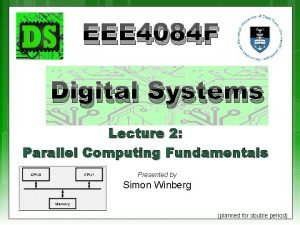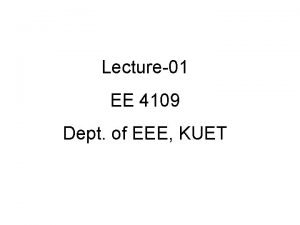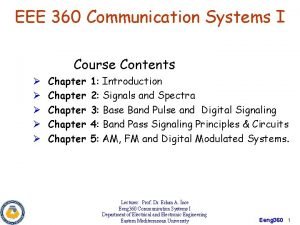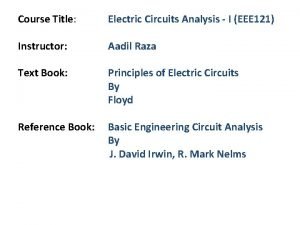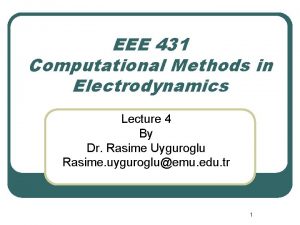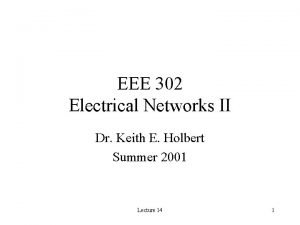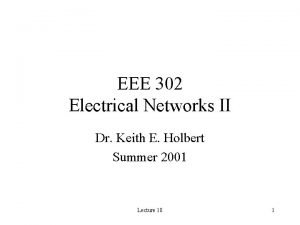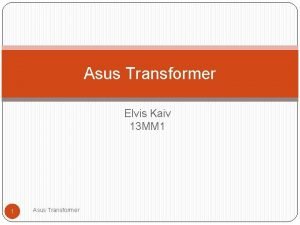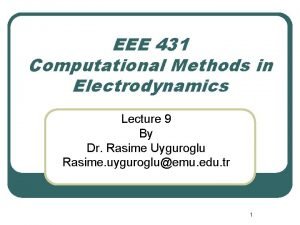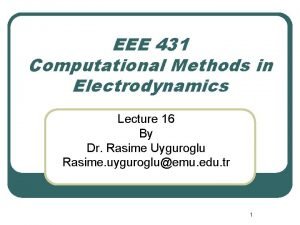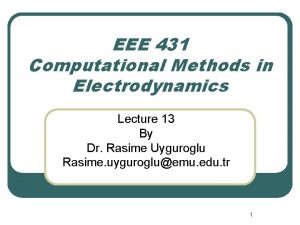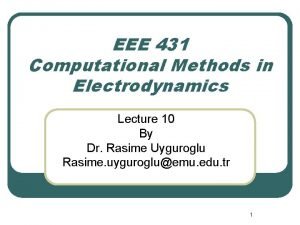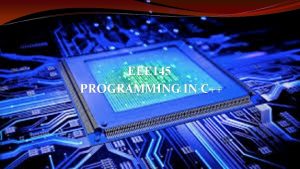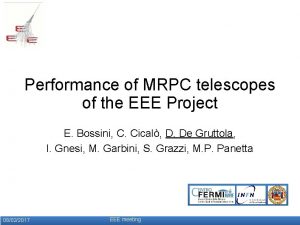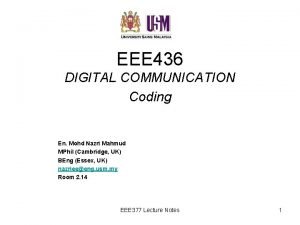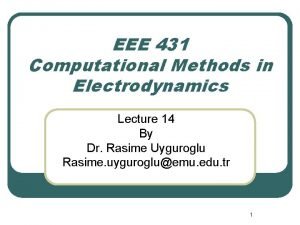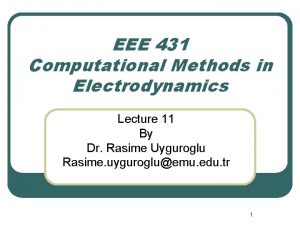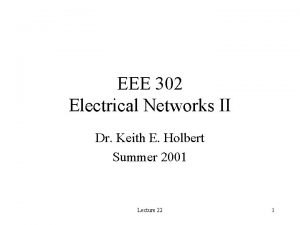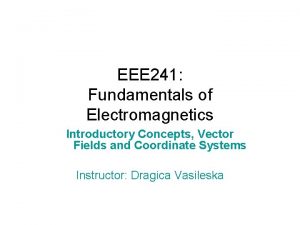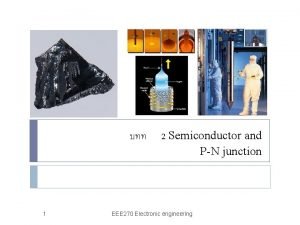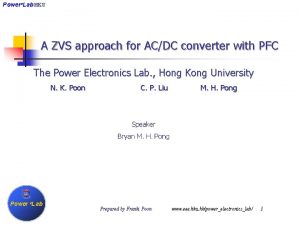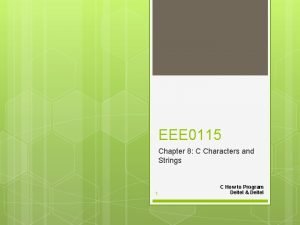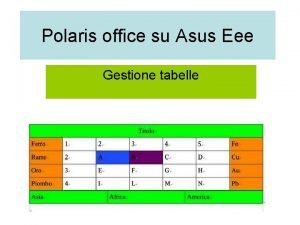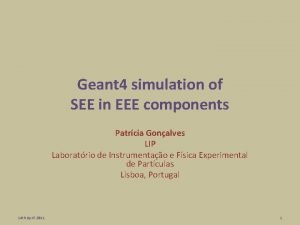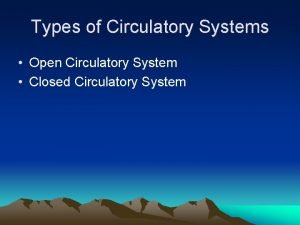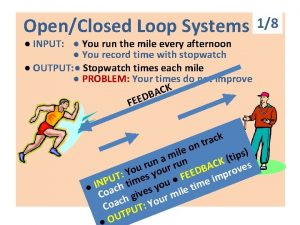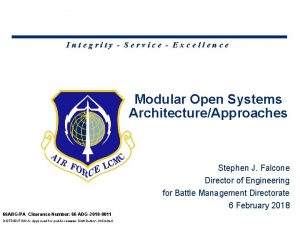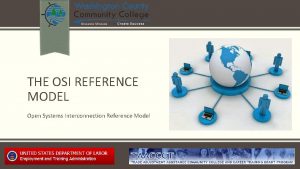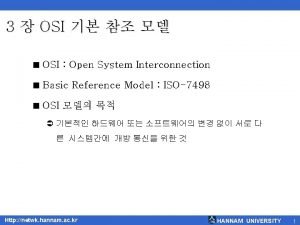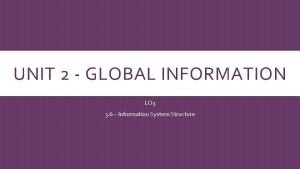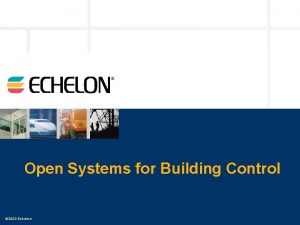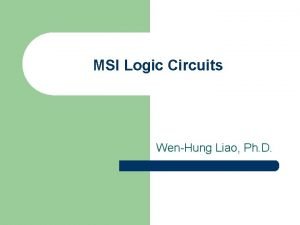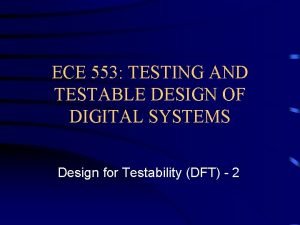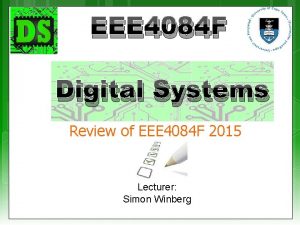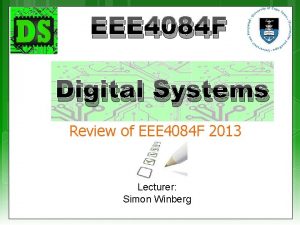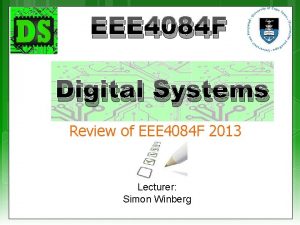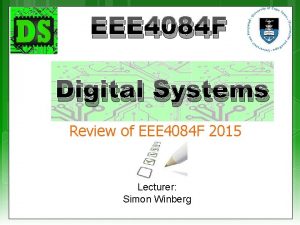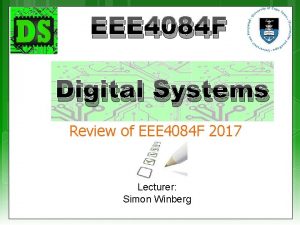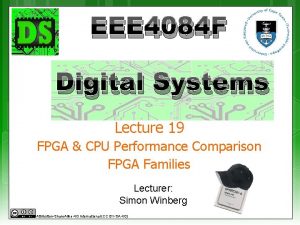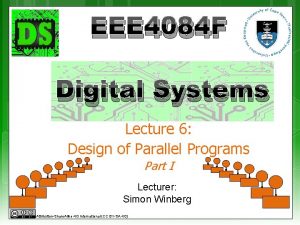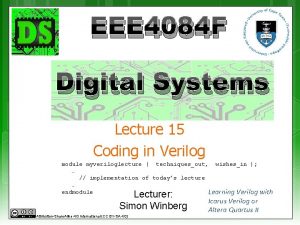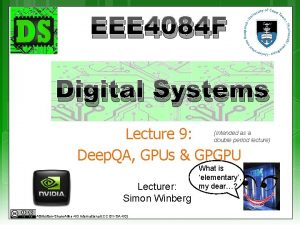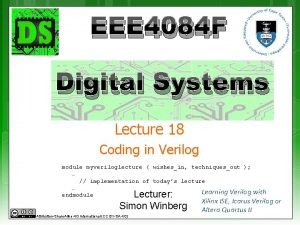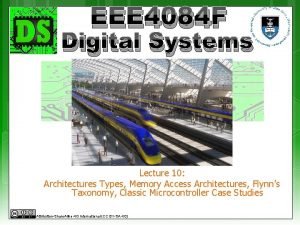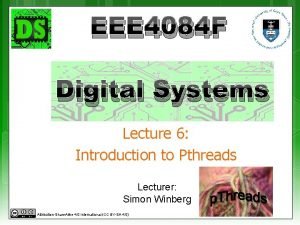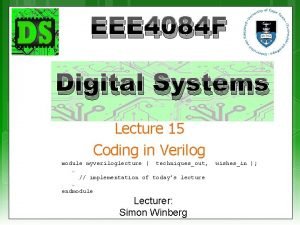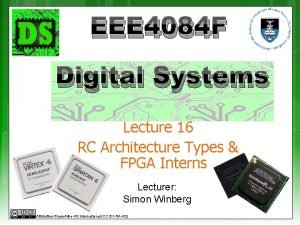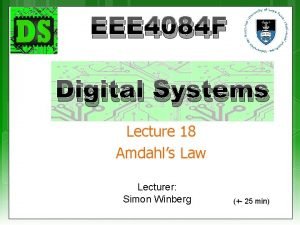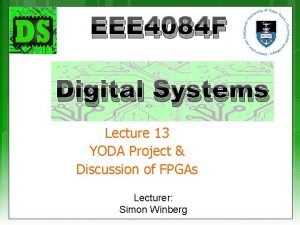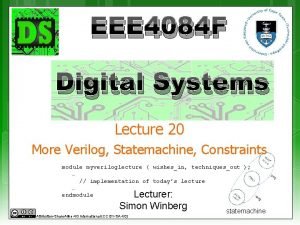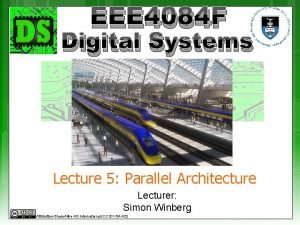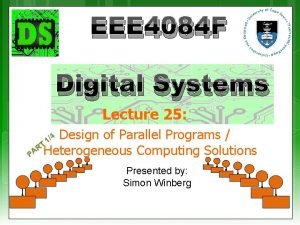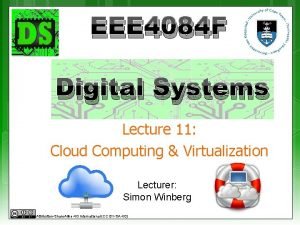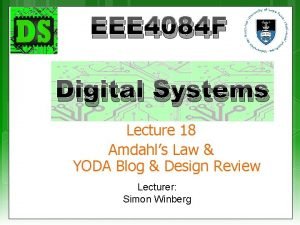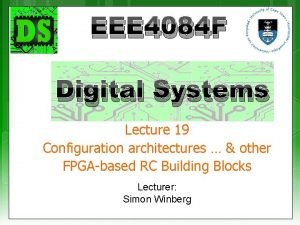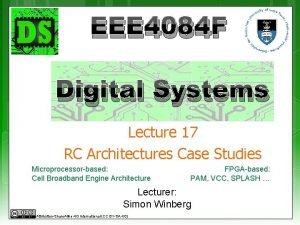EEE 4084 F Digital Systems Lecture 9 Open











![FPGA boards designed for use in datacentres The [Intel] Altera Arria 10 is a FPGA boards designed for use in datacentres The [Intel] Altera Arria 10 is a](https://slidetodoc.com/presentation_image_h/064b5b504e711ecc4110ee470c28fc65/image-12.jpg)

















































- Slides: 61

EEE 4084 F Digital Systems Lecture 9: Open. CL overview Lecturer: Simon Winberg Attribution-Share. Alike 4. 0 International (CC BY-SA 4. 0) Op w en ith ex CL am in pl C e

Lecture Overview Why Open. CL Brief overview of Open. CL Abstractions & platform model Open. CL Scenario Preparation for Prac 3 The following slides are based on a presentation prepared by Dr. Suleyman Demirsoy, DSP Technology Specialist, Intel Programmable Solutions Group See also paper in reading list: L 09 - 06502816 - Open. CL Overview, Implementation, and Performance Comparison. pdf Licensing details last slide

Why Open. CL? EEE 4084 F

Why Open. CL… Increasing demands for more functionality and performance Size of datasets and complexity of pipelines for moving data around continue to increase It’s an increasing struggle to sustain performance trajectory without massive increases in: cost, power & size Power consumption & thermal dissipation limits system size Control of data and synchronization complexity is growing out of control (i. e. complexity that develops in MPI code for large parallel systems)

Open. CL – for acceleration & other kernels Also a response for needs to cater for BIG DATA Host Computer Application Code mainly ‘glue code’ & GUI / IO HIGHLY INTEGRATED SYTEMS SPECIAL-PURPOSE ACCELERATORS Open. CL is not (currently) meant for creating most of the application code – it is designed around developing accelerated kernels that are highly parallel or exercise the specialized hardware (not necessarily an application accelerator) Reused Libraries lots of data Active kernel Inactive kernels Application Accelerator

Why Open. CL… Not all applications scale well linearly Not all apps load balance across all cores equally LIMITED SCALABILITY POORLY BALANCED

Why Open. CL… Heterogeneous Computing Systems as a potential solution to the problems of limited scalability and balancing Distribute your different processing needs among processing cores better suited to the particular types of processing. workload Essentially like matching the equipment with the task Definition: Heterogeneous computing refers to systems that use more than one kind of processor. These are systems that gain performance not just by adding the same type of processors, but by adding dissimilar processors, usually incorporating specialized processing capabilities to handle particular tasks (or entire applications).

Examples of devices form which heterogeneous computing systems are composed Multi-core, general purpose, central processing units (CPUs) Include multiple execution units ("cores") on the same chip Digital Signal Processing (DSPs) processors Optimized for the operational needs of digital signal processing Graphics Processing units (GPUs) Heavily optimized for graphics processing Field Programmable Gate Arrays (FPGAs) Custom architectures for each problem solved So. C FPGAs combine CPU+FPGA in single device

Challenges to developers Various applications becoming bottlenecked by scalable performance requirements e. g. Object detection and recognition, image tracking and processing, cryptography, cloud, search engines, deep packet inspection, etc… Overloading CPUs capabilities Frequencies capped Processors keep adding additional cores Need to coordinate all the cores and manage data Source: points based on course notes by B. Subramanian, Department of Computer Science, University of Texas, Austin

Challenges to developers (cont) Product life cycles are long GPUs lifespan is short (which goes with the problem of getting replacements of the same model in the future) Require re-optimization and regression testing between generations (not limited to accelerators/GPUs!! It could be some cryptic control code for a robot, e. g. multiple processors of an integrated device) Maintaining coherency throughout scalable system Support agreement for GPUs costly Power dissipation of CPUs and GPUs limits system size Source: points based on course notes by B. Subramanian, Department of Computer Science, University of Texas, Austin

FPGA in datacentres An increasing number of datacentres nowadays are having FPGAs a integral parts of their processing offerings. For example…
![FPGA boards designed for use in datacentres The Intel Altera Arria 10 is a FPGA boards designed for use in datacentres The [Intel] Altera Arria 10 is a](https://slidetodoc.com/presentation_image_h/064b5b504e711ecc4110ee470c28fc65/image-12.jpg)
FPGA boards designed for use in datacentres The [Intel] Altera Arria 10 is a high performance FPGA suited to these applications. The Nallatech PCI accelerator boards are an example of how a ‘supercomputer performing’ hybrid system can be constricted from a multi-core CPU + GPU + Nallatech FPGA custom accelerator board

FPGA boards designed for use in datacentres Another example of FPGA accelerator for a PC architecture: the Terasic DE 5 a-Net Terasic has lowest cost, highest performance platform offerings, you can get e. g. a DE 0 which connects via USB (while it has a reasonable FPGA

Open. CL – abstractions and platform model EEE 4084 F

Overview of Open. CL Open standard for parallel programming across heterogeneous devices Devices can consist of CPUs, GPUs, embedded processors etc. – uses all the processing resources available Includes a language based on C 99 for writing kernels and API used to define and control the devices Parallel computing (or hardware acceleration*) through task-based and data-based parallelism * Which is more generic e. g. if the hardware is faster but not necessarily more parallel

Purposes of Open. CL Use all computational resources of the system via a consistent programming language Greater platform independence Provides both a data and task parallel computational model A programming model which abstracts the specifics of the underlying hardware Much flexibility in specifying accuracy of floating-point computations Supports desktop, server, mobile, custom, etc.

The Open. CL Platform Model Context Device A - CPU Device B - GPU Context HOST Host connected to one or more Open. CL devices Device consists of one or more cores Execution per processor may be SIMD or SPMD* Contexts group together devices and enable inter-device communication This could simply be your workstation PC or a network server Device C - DSP * Single Program, Multiple Data - where cores are running the same program but not necessarily the same instructions at the same time Slide adapted from course notes by B. Subramanian, Department of Computer Science, University of Texas, Austin

Altera Open. CL Platform Model Developers mostly working happily at Application level in C for kernels and favourite application programming language The Open. CL compiler takes care of much of the worries including machinebased profiling, tuning and optimization

Open. CL Memory model Private memory: available per work item Local memory: shared in workgroup NB: No synchronization between workgroups Synchronization possible between work items in a common workgroup Global/constant memory accessible by any workitems (no guarantee to be synchronized) Host memory: access through the CPU PICe (usually) Memory management is explicit… � Data moved from: host->global->local and back �

Open. CL Memory model Private memory: available per work item Local memory: shared in workgroup NB: No synchronization between workgroups Synchronization possible between work items in a common workgroup Global/constant memory accessible by any workitems (no guarantee to be synchronized) Host memory: access through the CPU PICe (usually) Memory management is explicit… � Data moved from: host->global->local and back �

Open. CL Memory model Private memory: available per work item Local memory: shared in workgroup NB: No synchronization between workgroups Synchronization possible between work items in a common workgroup Global/constant memory accessible by any workitems (no guarantee to be synchronized) Host memory: access through the CPU PICe (usually) Memory management is explicit… � Data moved from: host->global->local and back �

Open. CL Memory model Private memory: available per work item Local memory: shared in workgroup NB: No synchronization between workgroups Synchronization possible between work items in a common workgroup Global/constant memory accessible by any workitems (no guarantee to be synchronized) Host memory: access through the CPU PICe (usually) Memory management is explicit… � Data moved from: host->global->local and back �

Open. CL Memory model Private memory: available per work item Local memory: shared in workgroup NB: No synchronization between workgroups Synchronization possible between work items in a common workgroup Global/constant memory accessible by any workitems (no guarantee to be synchronized) Host memory: access through the CPU PICe (usually) Memory management is explicit… � Data moved from: host->global->local and back �

Open. CL Memory model Private memory: available per work item Local memory: shared in workgroup NB: No synchronization between workgroups Synchronization possible between work items in a common workgroup Global/constant memory accessible by any workitems (no guarantee to be synchronized) Host memory: access through the CPU PICe (usually) Memory management is explicit… � Data moved from: host->global->local and back �

Advantages of Open. CL compiler HLS (high level synthesis) phase leverages the Open. CL compiler You can (if you want to) still specify and adjust: High performance datapaths Automatic pipelining New Qo. R enhancements as they are developed DSPB back-end optimizations Memory optimizations In addition to: Control constraints (latency, fmax, area, …) Control interfaces (stall, valid, Avalon-MM, …) Control architecture (memory configuration, scheduling, …) IP core verification flows Code. c IP optimizations executables

Open. CL Coding EEE 4084 F

Open. CL Programming Model Kernel Program Work items and Open. CL memory model Independent processing tasks; grouped into workgroups Workgroups one work-item per computation Work-items collection of kernels and related functions Kernels executed across a collection of work-items basic unit of execution – data parallel Work-items that executed together on one device Workgroups are executed independently can take place simultaneously or via specific schedule Applications structuring Queue kernel instances for execution in-order, but they may be executed in-order or out-of-order

Open. CL Objects Devices: multiple cores on CPU/GPU together taken as a single device Kernels executed across all cores in a data-parallel manner Contexts: Enable sharing between different devices (work task elements) Devices must be within the same context to be able to share Queues: used for submitting work, one per device Buffers: simple chunks of memory like arrays; read-write access Images: 2 D/3 D data structures Access using read_image(), write_image() Either read or write within a kernel, but not both

Open. CL Kernel Objects Declared with a kernel qualifier Encapsulate a kernel function Kernel objects are created after the executable is built Execution Set the kernel arguments Enqueue the kernel Kernels are executed asynchronously Events used to track the execution status Used for synchronizing execution of two kernels cl. Wait. For. Events(), cl. Enqueue. Marker() etc.

Open. CL Program Objects Encapsulate A program source/binary List of devices and latest successfully built executable for each device List of kernel objects Kernel source specified as a string can be provided and compiled at runtime using cl. Create. Program. With. Source() – platform independence Overhead – compiling programs can be expensive Open. CL allows for reusing precompiled binaries

Open. CL Overall Pipeline A view on how some of the objects fit in to the execution model

Open. CL C Language C 99 (previously ‘C 9 X’) is an informal name for ISO/IEC 9899: 1999, a past version of the C programming language standard. It extends the previous version (C 90) with new features for the language and the standard library. Helps implementations make better use of available computer hardware and compiler technology. Source & more info: https: //en. wikipedia. org/wiki/C 99 Derived from ISO C 99 Non standard headers, function pointers, recursion, variable length arrays, bit fields Added features: work-items, workgroups, vector types, synchronization Address space qualifiers Optimized image access re C! a Built-in functions specific to Open. CL se rom e f h f t ble Data-types o a y n iz Char, uchar, short, ushort, int, uint, long, ulong Ma cogn re Bool, intptr_t, ptrdiff_t, size_t, uintptr_t, half Image 2 d_t, image 3 d_t, sampler_t Vector types – portable, varying length (2, 4, 8, 16), endian safe Char 2, ushort 4, int 8, float 16, double 2 etc. (skip in lecture, may be useful to refer to when writing a Open. CL program)

Open. CL C Language Work-item and workgroup functions get_work_dim(), get_global_size() re C! a se n in e h f t mo o m ny co a o M ts no get_group_id(), get_local_id() Vector operations and components are pre-defined as a language feature Kernel functions get_global_id() – gets the next work item Conversions Explicit – convert_dest. Type<_sat><_rounding. Mode> Reinterpret – as_dest. Type Scalar and pointer conversions follow C 99 rules No implicit conversions/casts for vector typs (skip in lecture, may be useful to refer to when writing a Open. CL program)

Open. CL C Language: dealing with address spaces Address spaces Kernel pointer arguments must use global, local or constant Default for local variables is private Image 2 d_t and image 3 d_t are always in global address space Global variables must be in constant address space NB: Casting between different address spaces undefined (skip in lecture, may be useful to refer to when writing a Open. CL program)

Advantages of Open. CL Targets CPU, GPU and FPGAs Target user is Software developer Implements FPGA in software development flow Performance is determined by resources allocated Host Required C++ -> HDL translators Targets FPGA Target user is FPGA designer Implements FGPA in traditional FPGA development flow Performance is defined and amount of resource to achieve is reported Host not required (skip in lecture, may be useful to refer to when writing a Open. CL program)

CUDA vs Open. CL correspondence CUDA Thread-block Global memory Constant memory Shared memory Local memory __global__ function __device__ function __constant__ variable __device__ variable __shared__ variable Open. CL (skip in lecture, may be useful to refer to when writing a Open. CL program) Work-item Work-group Global memory Constant memory Local memory Private memory __kernel function no qualification needed __constant variable __global variable __local variable

Conceptual view of how a kernel fits in Similar to vertex buffers and textures Similar to depth and frame buffers Similar to vertex and fragment shaders … comparing to GPU / CUDA type approach …

Open. CL Scenario EEE 4084 F

Initialisation 1. 2. 3. 4. 5. 6. 7. 8. Get platform ID Compile kernels Create buffers Create command queue Enqueue write Enqueue kernel run Enqueue read Wait for queue to finish Wait for the Open. CL system to finish performing the commands in the queue

Matrix Multiplication Example Let’s multiply two Nx. N matrices, A and B, and store the result in Y.

C++ Implementation (Golden Measure)

Open. CL implementation Golden measure, the cpu has a double nested for loop i. e. i: 0 ->N-1 j: 0 ->N-1 k: 0 ->N-1 GPU version is going to have Nx. N threads, calculating the result for each Y[i, j] so each core should do just one for loop (i. e. the inner loop of the golden measure) i. e. k: 0 ->N-1 to compure Y[i, j]) So need to group the threads into a 2 D Nx. N structure, so that the thread IDs will have ID(0) going form 0. . N-1 (for columns) and ID(1) going from 0. . N-1 (for rows) Let’s start by defining the Open. CL kernel …

Open. CL Implementation /** This Kernel perform part of the standard matrix multiply on two Nx. N matrices, calculating one of the output elements: Sum of A(k, i) x B(j, k) for k=0. . N-1. */ __kernel void Multiply( __global float* A, __global float* B, __global float* Output, const unsigned int N ) { const int i = get_global_id(1); // Row const int j = get_global_id(0); // Column int k; float result = 0; for (k = 0; k < N; k++){ result += A[N*i + k] * B[N*k + j]; } Output[N*j + i] = result; } Put this in a file called e. g. Kernel. cl

Code to execute the kernel Writing the kernel was easy… But now we need to write the surrounding CPU-based code that 1. 2. 3. 4. 5. 6. 7. 8. 9. 10. Initialize the Open. CL driver Load the kernel (and compiles it) Creates on the CPU some test data Structures the kernel thread execution dimensions (kernel global ID dimensions) Sets up the memory buffers on the GPU (to hold input and output matrices) [Run a golden measure for checking the output] Send the test data from CPU to GPU Run the kernel Read back the result from the kernel [Compare the golden measure to the kernel result]


Initialize the driver • • First create a main. c program and project as needed. The main. c will run on the CPU Set up a main() function Now we can initialize the Open. CL library that connects to the driver if( !Open. CL_Init("NVIDIA" ) && // n. Vidia !Open. CL_Init("Advanced Micro Devices") && // AMD !Open. CL_Init(0 ) // Default ){ printf("Error: Cannot initialise Open. CL. n"); return 1; } In this code we attempt first to connect to a n. Vidia device, then if that fails we try to connect to an AMD device (many come with a graphics driver that support Open. CL) and if neither of those work, the tries a default (any other device, e. g. Intel multicore processor driver for Open. CL). If we can’t find any device the program might as well exit.

Initialize the driver • Let’s start by loading in and compiling the kernel (assuming the Kernel is in a file Kernel. cl and in a subdirectory for the project called Open. CL) • This is a tip: separate your kernels from the rest of the CPU code, I like putting it in a subdirectory Open. CL if(!Open. CL_Load. Kernel("Open. CL/Kernel. cl", "Multiply")) return 1; If there any syntax errors then this command will fail, possibly displaying error information to the screen depending on what Open. CL driver you use.

Set up memory • Set up buffers on the CPU that will hold the matrices to multiple as well as the result. // Choose the matrix size and how much memory it needs N = 3; size_t Buffer. Size = N*N*sizeof(float); // Allocate CPU RAM A = (float*)malloc(Buffer. Size); B = (float*)malloc(Buffer. Size); Output_Serial = (float*)malloc(Buffer. Size); Output_Open. CL = (float*)malloc(Buffer. Size); To start with we’re doing a trivial 3 x 3 matrix. Why? So that we can print it easily to the screen and inspect the result manually to check all it is working. The inputs are called A and B, I’ve set up two output matrices: Output_Serial for the golden measure and Output_Open. CL for the kernel return.

Initialize the matrices • Let’s define a function Fill to populate the matrices /** Fill an Nx. N matrix with random values ranging from 0 to 20 */ void Fill(float* A){ int i, j; for(j = 0; j < N; j++){ for(i = 0; i < N; i++){ A[N*j + i] = rand() % 20; } } } We’re just initializing with random values, but making them ints between 0 and 19 so as to be displayed easily. It’s doesn’t make a difference to the speed when running the multiply.

Initialize the matrices • Use the Full function we just did to populate the matrices // Provide seed to random number generator srand(time(NULL)); // Put data into the matrices Fill(A); Fill(B);

Set up kernel thread dimensions and memory • We want the threads to be arranged in a 2 D grid, 0. . N-1 x 0. . N-1 • We want to have 3 x buffers on the GPU for A, B matrix inputs and C output size_t Local. Size[2] = {1, 1}; // dimensions of threads Open. CL_Prepare. Local. Size(N, Local. Size); // Allocate GPU memory… // This is buffer ID 0 and it is read only (write protected) A_Buffer = Open. CL_Create. Buffer(0, CL_MEM_READ_ONLY, Buffer. Size); // This is buffer ID 1 and it is read only (write protected) B_Buffer = Open. CL_Create. Buffer(1, CL_MEM_READ_ONLY, Buffer. Size); // This is buffer ID 2 and it is write only Output. Buffer = Open. CL_Create. Buffer(2, CL_MEM_WRITE_ONLY, Buffer. Size);

Run the serial golden measure • Let’s run the serial version that was already given as the golden measure (placed in function Process_Serial) • Note that we are using the tic and toc C implementations see in earlier lectures (these are attached below in the Timer module) tic(); Process_Serial(); printf("Serial: %lg msn", toc()/1 e-3); /** This function does a complete Matrix multiply of an Nx. N matrix, calculating the output elements: Sum of A(k, i) x B(j, k) for k=0. . N-1. */ void Process_Serial(){ int i, j, k; float result; for(j = 0; j < N; j++){ for(i = 0; i < N; i++){ result = 0; for(k = 0; k < N; k++){ result += A[N*i + k] * B[N*k + j]; } Output_Serial[N*j + i] = result; } } }

Run the Open. CL version • Let’s run the open. CL kernel • The process for invoking the kernel can be put in a separate function to make the main function less complicated (see next slide) tic(); Process_Open. CL(); printf("n. Open. CL: %lg msnn", toc()/1 e-3);

Run the Open. CL version • Procedure for invoking the kernel… /** Set up the data on the GPU and Run the kernel. */ void Process_Open. CL(){ printf("n"); // Send N as argument 3. Note that arguments are indexed from 0 Open. CL_Constant. Int(3, N); // Send over the buffers A and B to the GPU memory Open. CL_Write. Data(A_Buffer, N*N*sizeof(float), A); Open. CL_Write. Data(B_Buffer, N*N*sizeof(float), B); // Execute the kernel function Open. CL_Run(N, Local. Size); // Read back the result from the GPU Open. CL_Read. Data(Output. Buffer, N*N*sizeof(float), Output_Open. CL); }

Compare CPU & GPU results • Now lets compare the golden measure (Openput_Serial) with the kernel output (Output_Open. CL). Just call this function from main(). /** Compare the Output_Serial and Output_Open. CL matrices and indicate if they are the same or not. */ void Compare(){ int i, j; // compare the two result matrices int same = 1; for(j = 0; j < N; j++){ for(i = 0; i < N; i++){ if (Output_Serial[N*j + i] != Output_Open. CL[N*j + i]) same=0; } } if (same) printf(" Result matrices are the same : )n"); else printf(" Result matrices differ!!n"); }

Clean up • And at the end of the main() function remember to free the allocated memory on both the CPU and on the GPU // Dispose of the allocated memory on CPU and on GPU free(A); free(B); free(Output_Serial); free(Output_Open. CL); Open. CL_Free. Buffer(A_Buffer ); Open. CL_Free. Buffer(B_Buffer ); Open. CL_Free. Buffer(Output. Buffer); Open. CL_Destroy();

What does the output look like? Should see something like the following (this example run was done on a Intel i 5 with a n. Vidia GForce GTX 550 Ti card. -- dump of various Open. CL driver information -Should see vendors of Intel(R) Corporation and NVIDIA Corporation Clock resolution: 342. 1 ns Serial: 0. 000342102 ms Local work group size: 3 x 3 Open. CL: 1. 26679 ms Result matrices are the same : ) A: 9 12 9 14 7 5 14 1 1 B: 18 4 11 10 19 19 17 9 3 Output_Serial: 435 407 279 345 234 84 354 302 176 Output_Open. CL: 435 407 279 345 234 84 354 302 176 Note that with these tiny 3 x 3 matrices the time to get data to the GPU and invoke the kernel takes way longer than doing the actual multiplication. N=100 was just past the breakeven point. Taking N over 500 started seeing substantial differences (e. g. for N=1000 got: Serial: 7295. 86 ms vs. Open. CL: 63. 9901 ms)

Further Reading R Wright, N Haemel and G Sellers Open. GL Super. Bible, 6 th ed Addison-Wesley, 2014, ISBN 978 -0 -321 -90294 -8 A Munshi, B R Gaster, T G Mattson, J Fung and D Ginsburg Open. CL Programming Guide Addison-Wesley, 2012, ISBN 978 -0 -321 -74964 -2 Mac Developer Library Open. CL Hello World Example Altera Open. CL SDK for FPGA

Complete application See the Prac 3 on the EEE 4084 F website (attached here a. zip of the current version used in this presentation, with a Code: : Blocks project, should compile on Linux or Windows)

End of lecture

Disclaimers and copyright/licensing details I have tried to follow the correct practices concerning copyright and licensing of material, particularly image sources that have been used in this presentation. I have put much effort into trying to make this material open access so that it can be of benefit to others in their teaching and learning practice. Any mistakes or omissions with regards to these issues I will correct when notified. To the best of my understanding the material in these slides can be shared according to the Creative Commons “Attribution-Share. Alike 4. 0 International (CC BY-SA 4. 0)” license, and that is why I selected that license to apply to this presentation (it’s not because I particularly want my slides referenced but more to acknowledge the sources and generosity of others who have provided free material such as the images I have used). Image sources: Wikipedia (open commons) commons. wikimedia. org flickr. com Gadgets, Block diagrams for Altera Open. CL models – fair usage public domain CC 0 (http: //pixabay. com/)
 Q6 4084
Q6 4084 영국 beis
영국 beis 01:640:244 lecture notes - lecture 15: plat, idah, farad
01:640:244 lecture notes - lecture 15: plat, idah, farad Eee kuet
Eee kuet Eee 360
Eee 360 Eee ankara
Eee ankara Eee 121
Eee 121 Eee 431
Eee 431 Eee 302
Eee 302 Eee 302
Eee 302 Tahvel.edu.eee
Tahvel.edu.eee Eee 431
Eee 431 Eee 431
Eee 431 Eee 431
Eee 431 Eee 431
Eee 431 Eee 145
Eee 145 Eee
Eee Lempel-ziv coding in digital communication
Lempel-ziv coding in digital communication Eee 431
Eee 431 Eee 431
Eee 431 3 phase short circuit
3 phase short circuit Quality factor of rlc circuit
Quality factor of rlc circuit Eee241
Eee241 Eee
Eee ëëë
ëëë Eee
Eee Android asus eee pc
Android asus eee pc Powere
Powere Flash pdf
Flash pdf Schematic arrangement of diesel power plant
Schematic arrangement of diesel power plant Eee
Eee Eee components
Eee components Eee office
Eee office Asus xgu2008
Asus xgu2008 Metu
Metu Eee components
Eee components Eee202
Eee202 Operating system lecture notes
Operating system lecture notes Articulators
Articulators Lecture sound systems
Lecture sound systems Normally open timed closed contact symbol
Normally open timed closed contact symbol Open hearts open hands
Open hearts open hands Hukum digitalmengatur tentang
Hukum digitalmengatur tentang E-commerce digital markets digital goods
E-commerce digital markets digital goods Digital data digital signals
Digital data digital signals Data encoding and modulation
Data encoding and modulation E-commerce: digital markets, digital goods
E-commerce: digital markets, digital goods Signal encoding techniques in data communication
Signal encoding techniques in data communication Luxembourg digital innovation hub
Luxembourg digital innovation hub E-commerce digital markets digital goods
E-commerce digital markets digital goods Open and closed stratification systems
Open and closed stratification systems Do clams have a closed circulatory system
Do clams have a closed circulatory system Closed loop system
Closed loop system Open closed and isolated systems
Open closed and isolated systems Modular open systems architecture
Modular open systems architecture Network security monitoring nsm open systems
Network security monitoring nsm open systems Open system interconnection reference model
Open system interconnection reference model Open systems interconnect
Open systems interconnect Open and closed system in thermodynamics
Open and closed system in thermodynamics Agenda open systems
Agenda open systems Msi digital systems
Msi digital systems Digital systems testing and testable design
Digital systems testing and testable design
